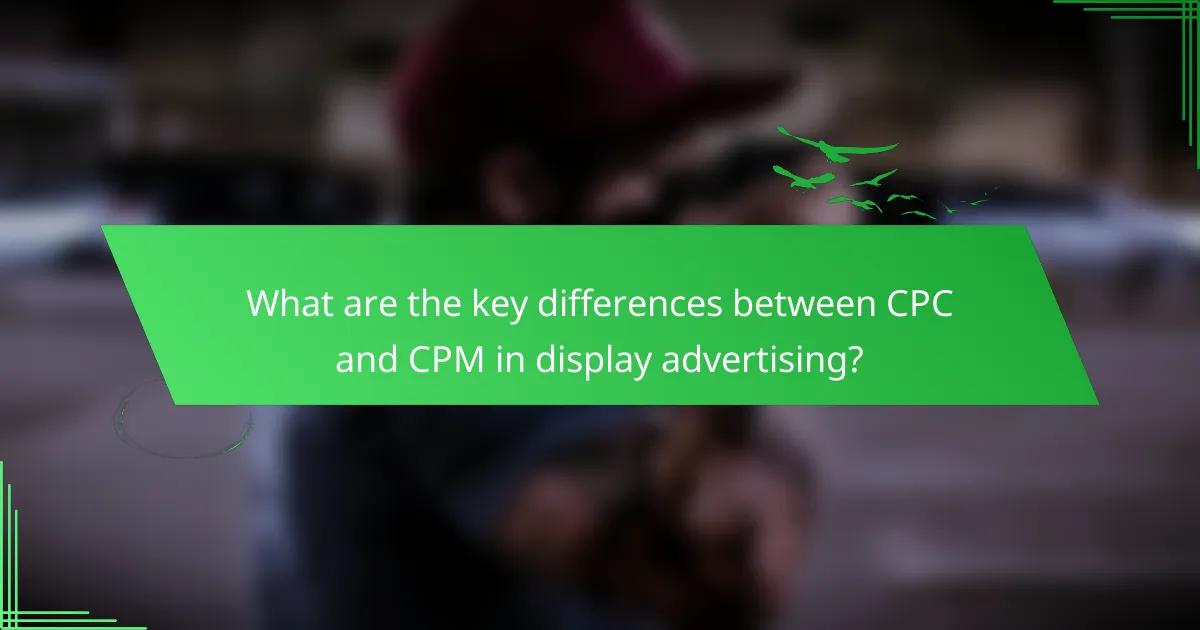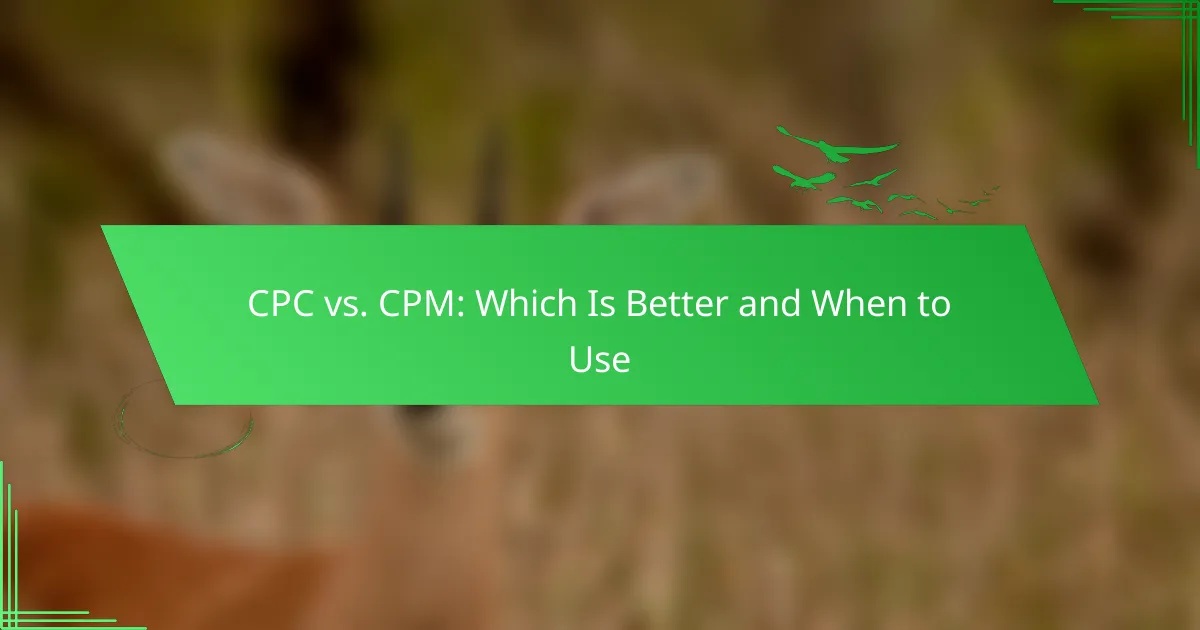CPC (Cost Per Click) and CPM (Cost Per Thousand Impressions) are two distinct pricing models in display advertising, each serving different campaign objectives. CPC is best for driving immediate actions like website visits, while CPM is suited for maximizing visibility and brand awareness. Understanding when to use each model can significantly impact the effectiveness of your advertising strategy.

What are the key differences between CPC and CPM in display advertising?
CPC (Cost Per Click) and CPM (Cost Per Thousand Impressions) are two distinct pricing models in display advertising. CPC charges advertisers based on the number of clicks their ads receive, while CPM charges based on the number of impressions, or views, the ads generate.
CPC focuses on cost per click
CPC advertising means you only pay when a user clicks on your ad, making it a performance-based model. This approach is ideal for campaigns aimed at driving traffic to a website or generating leads, as it directly correlates costs with user engagement.
For example, if you set a CPC of $1 and receive 100 clicks, your total cost will be $100. This model encourages advertisers to optimize their ads for higher click-through rates (CTR) to maximize their return on investment.
CPM emphasizes cost per thousand impressions
CPM advertising charges a fixed rate for every thousand impressions, regardless of whether users interact with the ad. This model is beneficial for brand awareness campaigns where the goal is to reach a large audience rather than drive immediate clicks.
For instance, if your CPM rate is $5, you would pay $5 for every 1,000 times your ad is displayed. This approach is often used for products or services that benefit from broad visibility.
Targeting strategies differ
CPC campaigns typically focus on targeting specific audiences likely to engage with the ad, using keywords and demographics to refine reach. This ensures that the clicks generated are from users who are more likely to convert.
In contrast, CPM campaigns may prioritize broader targeting strategies to maximize impressions. Advertisers might use general demographics or interests, aiming to create brand recognition rather than immediate action.
Performance metrics vary
In CPC campaigns, key performance indicators include click-through rates, conversion rates, and cost per acquisition. These metrics help advertisers assess the effectiveness of their ads in driving user actions.
For CPM campaigns, metrics focus on impressions, reach, and frequency. Advertisers track how many people saw their ads and how often they were displayed, which is crucial for evaluating brand visibility and awareness.

When should I use CPC for my campaigns?
CPC, or cost-per-click, is ideal for campaigns focused on driving immediate actions, such as website visits or conversions. Use CPC when you want to pay only for actual clicks, making it a cost-effective choice for direct response marketing.
Use CPC for direct response goals
CPC is particularly effective for campaigns aimed at generating direct responses from potential customers. This includes actions like signing up for a newsletter, making a purchase, or requesting more information. By focusing on clicks, you can directly measure the effectiveness of your advertising efforts.
When setting up your campaign, ensure that your ad copy and landing pages are optimized for conversions. This alignment will help maximize the return on your CPC investment.
Best for campaigns with clear call-to-action
Utilizing CPC works best when your campaign has a clear and compelling call-to-action (CTA). A strong CTA encourages users to click through to your site, which can lead to higher conversion rates. Examples of effective CTAs include “Buy Now,” “Sign Up Today,” or “Learn More.”
Ensure that your landing page matches the promise of your ad’s CTA. If users click expecting one thing but find another, your conversion rates may suffer.
Effective for niche targeting
CPC is advantageous for targeting niche markets where specific audiences are more likely to convert. By focusing on a well-defined demographic or interest group, you can tailor your ads to resonate with that audience, increasing the likelihood of clicks and conversions.
Consider using tools like Google Ads or Facebook Ads to refine your targeting. These platforms allow you to set parameters such as location, interests, and behaviors, ensuring your ads reach the right people effectively.

When is CPM the better choice?
CPM, or cost per thousand impressions, is often the better choice when the goal is to maximize visibility rather than immediate clicks or conversions. This model is particularly effective for campaigns focused on brand awareness and reaching a broad audience.
Use CPM for brand awareness campaigns
CPM is ideal for brand awareness campaigns because it prioritizes exposure over direct engagement. Advertisers pay for impressions, ensuring that their ads are seen by a large number of potential customers, which is crucial for building brand recognition.
For instance, a company launching a new product may choose a CPM model to ensure maximum visibility across various platforms, even if immediate sales are not the primary goal. This approach helps create familiarity and interest among consumers.
Ideal for reaching large audiences
Using CPM is particularly effective for reaching large audiences, as it allows advertisers to spread their message widely without focusing on specific actions. This model is beneficial for campaigns targeting demographics that may not be actively searching for a product but can be influenced by repeated exposure.
For example, a national brand may run a CPM campaign on social media or display networks to ensure that their ads are seen by millions, increasing the likelihood of brand recall and future engagement.
Effective for display ad visibility
CPM is especially effective for display ads, where the goal is to capture attention rather than drive immediate clicks. Advertisers can benefit from high visibility on popular websites and apps, ensuring their ads are seen by users as they browse content.
When using CPM for display advertising, it’s important to select placements that align with the target audience. For instance, placing ads on high-traffic sites relevant to the brand can enhance visibility and reinforce brand messaging effectively.

How do I decide between CPC and CPM?
Choosing between Cost Per Click (CPC) and Cost Per Mille (CPM) depends on your advertising goals and budget. CPC is ideal for driving traffic and conversions, while CPM is better for brand awareness and impressions.
Evaluate campaign objectives
Your campaign objectives are crucial in deciding between CPC and CPM. If your goal is to generate leads or sales, CPC allows you to pay only when users click on your ad, making it cost-effective for performance-driven campaigns. Conversely, if you aim to increase brand visibility and reach a larger audience, CPM can be more suitable as it charges based on impressions.
Consider budget constraints
Budget constraints play a significant role in your decision-making process. CPC campaigns can be more flexible, allowing you to set daily or monthly limits based on how much you are willing to spend per click. On the other hand, CPM campaigns may require a larger upfront investment since you pay for every thousand impressions, which can be more challenging for tight budgets.
Analyze audience engagement
Understanding audience engagement is essential when choosing between CPC and CPM. If your target audience is highly engaged and likely to click on ads, CPC may yield better returns. However, if your audience is less likely to interact but responds well to brand exposure, CPM could be the better option, ensuring your message reaches them frequently.

What are the advantages of CPC in Canada?
CPC, or Cost Per Click, offers several advantages for advertisers in Canada, particularly in terms of budget management and campaign effectiveness. By paying only when a user clicks on an ad, businesses can optimize their spending and focus on driving traffic to their websites.
Higher control over ad spending
CPC allows advertisers to maintain tighter control over their ad budgets. Since costs are incurred only when users engage with the ad, businesses can set daily or monthly spending limits to prevent overspending. This model is particularly beneficial for small to medium-sized enterprises looking to maximize their marketing ROI.
For example, if a company allocates CAD 500 for a campaign, they can monitor clicks and adjust bids accordingly to ensure they stay within budget. This flexibility helps in managing costs effectively while still reaching potential customers.
Better tracking of user engagement
With CPC, tracking user engagement becomes straightforward. Advertisers can analyze click-through rates (CTR) to gauge how well their ads resonate with the target audience. This data is essential for refining ad strategies and improving overall campaign performance.
By examining metrics such as the number of clicks versus impressions, businesses can identify which ads are performing well and which need adjustments. This insight allows for more informed decisions regarding ad placements and content, ultimately leading to better engagement.
Optimized for conversion-focused campaigns
CPC is particularly effective for campaigns aimed at conversions, such as sales or lead generation. Since advertisers pay for actual clicks, they can focus on attracting users who are more likely to convert, rather than just increasing visibility.
For instance, a Canadian e-commerce store may use CPC to target specific keywords related to their products. By doing so, they can attract potential buyers actively searching for those items, increasing the likelihood of conversions and maximizing the effectiveness of their advertising spend.

What are the advantages of CPM in Canada?
CPM, or cost per thousand impressions, offers several advantages in Canada, particularly for advertisers aiming to maximize exposure. It is particularly beneficial for campaigns focused on brand awareness rather than direct conversions.
Cost-effective for high-volume impressions
Using CPM can be a cost-effective strategy when targeting a large audience. Advertisers can secure a significant number of impressions at a lower cost compared to other pricing models like CPC (cost per click). This is especially useful for brands looking to reach a broad demographic without overspending.
For example, if a campaign has a budget of CAD 1,000 and the CPM rate is CAD 10, the advertiser can expect to achieve around 100,000 impressions. This high volume can lead to increased recognition and recall among potential customers.
Increased brand visibility
CPM campaigns are designed to enhance brand visibility by ensuring that ads are displayed frequently to users. This repeated exposure can help solidify brand identity and make it more memorable to consumers. In Canada, where competition can be fierce, maintaining a strong presence is crucial.
Moreover, CPM is effective for campaigns that aim to build brand awareness over time. By consistently appearing in front of the target audience, brands can foster familiarity and trust, which are essential for long-term loyalty.
